CS231n
10
Andrej Karpathy
ID
Python Numpy
CS231n
Python Numpy Tutorial
Flood Sung
SunisDown
Justin Johnson
Python
numpy, scipy, matplotlib
Python
Python
Numpy
Python
Python
Python
Matlab
numpy for Matlab users
IPython notebook
Volodymyr Kuleshov
Isaac
Caswell
CS 228
Python
课
程
笔
记
翻
译
:
教
程
译
者
注
:
本
文
智
能
单
元
首
发
,
翻
译
自
斯
坦
福
课
程
笔
记
,
由
课
程
教
师
授
权
进
行
翻
译
。
本
篇
教
程
由
杜
客
翻
译
完
成
,
、
、
巩
子
嘉
和
一
位
不
愿
透
露
的
知
友
对
本
翻
译
亦
有
贡
献
。
原
文
如
下
这
篇
教
程
由
创
作
。
我
们
将
使
用
编
程
语
言
来
完
成
本
课
程
的
所
有
作
业
。
是
一
门
伟
大
的
通
用
编
程
语
言
,
在
一
些
常
用
库
(
)
的
帮
助
下
,
它
又
会
变
成
一
个
强
大
的
科
学
计
算
环
境
。
我
们
期
望
你
们
中
大
多
数
人
对
于
语
言
和
库
比
较
熟
悉
,
而
对
于
没
有
经
验
的
同
学
,
这
篇
教
程
可
以
帮
助
你
们
快
速
了
解
编
程
环
境
和
如
何
使
用
作
为
科
学
计
算
工
具
。
一
部
分
同
学
对
于
有
一
定
经
验
。
对
于
这
部
分
同
学
,
我
们
推
荐
阅
读
页
面
。
你
们
还
可
以
查
看
本
教
程
的
版
。
该
教
程
是
由
和
为
课
程
创
建
的
。
内
容
列
表
:
基
本
数
据
类
型
容
器
列
表
字
典
杜
客
个
月
前
�
Numpy
SciPy
MATLAB
Matplotlib
Python
Python
Python
quicksort
Python
def quicksort(arr):
if len(arr) <= 1:
return arr
pivot = arr[len(arr) / 2]
left = [x for x in arr if x < pivot]
middle = [x for x in arr if x == pivot]
right = [x for x in arr if x > pivot]
return quicksort(left) + middle + quicksort(right)
集
合
元
组
函
数
类
数
组
访
问
数
组
数
据
类
型
数
组
计
算
广
播
图
像
操
作
文
件
点
之
间
的
距
离
绘
制
图
形
绘
制
多
个
图
形
图
像
是
一
种
高
级
的
,
动
态
类
型
的
多
范
型
编
程
语
言
。
很
多
时
候
,
大
家
会
说
看
起
来
简
直
和
伪
代
码
一
样
,
这
是
因
为
你
能
够
通
过
很
少
行
数
的
代
码
表
达
出
很
有
力
的
思
想
。
举
个
例
子
,
下
面
是
用
实
现
的
经
典
的
算
法
例
子
:
�
print quicksort([3,6,8,10,1,2,1])
# Prints "[1, 1, 2, 3, 6, 8, 10]"
Python
Python
2.7
3.4
2.7
3.4
3.0
2.7
python --version
Python
x = 3
print type(x) # Prints ""
print x # Prints "3"
print x + 1 # Addition; prints "4"
print x - 1 # Subtraction; prints "2"
print x * 2 # Multiplication; prints "6"
print x ** 2 # Exponentiation; prints "9"
x += 1
print x # Prints "4"
x *= 2
print x # Prints "8"
y = 2.5
print type(y) # Prints ""
print y, y + 1, y * 2, y ** 2 # Prints "2.5 3.5 5.0 6.25"
Python
x++
x--
Python
Python
&&
||
t = True
f = False
print type(t) # Prints ""
print t and f # Logical AND; prints "False"
版
本
有
两
个
支
持
的
版
本
,
分
别
是
和
。
这
有
点
让
人
迷
惑
,
向
语
言
中
引
入
了
很
多
不
向
后
兼
容
的
变
化
,
下
的
代
码
有
时
候
在
下
是
行
不
通
的
。
在
这
个
课
程
中
,
我
们
使
用
的
是
版
本
。
如
何
查
看
版
本
呢
?
使
用
命
令
。
基
本
数
据
类
型
和
大
多
数
编
程
语
言
一
样
,
拥
有
一
系
列
的
基
本
数
据
类
型
,
比
如
整
型
、
浮
点
型
、
布
尔
型
和
字
符
串
等
。
这
些
类
型
的
使
用
方
式
和
在
其
他
语
言
中
的
使
用
方
式
是
类
似
的
。
数
字
:
整
型
和
浮
点
型
的
使
用
与
其
他
语
言
类
似
。
需
要
注
意
的
是
,
中
没
有
和
的
操
作
符
。
也
有
内
置
的
长
整
型
和
复
杂
数
字
类
型
,
具
体
细
节
可
以
查
看
文
档
。
布
尔
型
:
实
现
了
所
有
的
布
尔
逻
辑
,
但
用
的
是
英
语
,
而
不
是
我
们
习
惯
的
操
作
符
(
比
如
和
等
)
。
�
print t or f # Logical OR; prints "True"
print not t # Logical NOT; prints "False"
print t != f # Logical XOR; prints "True"
Python
hello = 'hello' # String literals can use single quotes
world = "world" # or double quotes; it does not matter.
print hello # Prints "hello"
print len(hello) # String length; prints "5"
hw = hello + ' ' + world # String concatenation
print hw # prints "hello world"
hw12 = '%s %s %d' % (hello, world, 12) # sprintf style string formatting
print hw12 # prints "hello world 12"
s = "hello"
print s.capitalize() # Capitalize a string; prints "Hello"
print s.upper() # Convert a string to uppercase; prints "HELLO"
print s.rjust(7) # Right-justify a string, padding with spaces; prints " hello"
print s.center(7) # Center a string, padding with spaces; prints " hello "
print s.replace('l', '(ell)') # Replace all instances of one substring with another;
# prints "he(ell)(ell)o"
print ' world '.strip() # Strip leading and trailing whitespace; prints "world"
Containers
container
Python
tuples
Lists
Python
lists
dictionaries
sets
xs = [3, 1, 2] # Create a list
print xs, xs[2] # Prints "[3, 1, 2] 2"
print xs[-1] # Negative indices count from the end of the list; prints "2"
xs[2] = 'foo' # Lists can contain elements of different types
print xs # Prints "[3, 1, 'foo']"
字
符
串
:
对
字
符
串
的
支
持
非
常
棒
。
字
符
串
对
象
有
一
系
列
有
用
的
方
法
,
比
如
:
如
果
想
详
细
查
看
字
符
串
方
法
,
请
看
文
档
。
容
器
译
者
注
:
有
知
友
建
议
翻
译
为
复
合
数
据
类
型
,
供
读
者
参
考
。
有
以
下
几
种
容
器
类
型
:
列
表
(
)
、
字
典
(
)
、
集
合
(
)
和
元
组
(
)
。
列
表
列
表
就
是
中
的
数
组
,
但
是
列
表
长
度
可
变
,
且
能
包
含
不
同
类
型
元
素
。
�
xs.append('bar') # Add a new element to the end of the list
print xs # Prints
x = xs.pop() # Remove and return the last element of the list
print x, xs # Prints "bar [3, 1, 'foo']"
Slicing
Python
nums = range(5) # range is a built-in function that creates a list of integers
print nums # Prints "[0, 1, 2, 3, 4]"
print nums[2:4] # Get a slice from index 2 to 4 (exclusive); prints "[2, 3]"
print nums[2:] # Get a slice from index 2 to the end; prints "[2, 3, 4]"
print nums[:2] # Get a slice from the start to index 2 (exclusive); prints "[0, 1]"
print nums[:] # Get a slice of the whole list; prints ["0, 1, 2, 3, 4]"
print nums[:-1] # Slice indices can be negative; prints ["0, 1, 2, 3]"
nums[2:4] = [8, 9] # Assign a new sublist to a slice
print nums # Prints "[0, 1, 8, 8, 4]"
Numpy
Loops
animals = ['cat', 'dog', 'monkey']
for animal in animals:
print animal
# Prints "cat", "dog", "monkey", each on its own line.
enumerate
animals = ['cat', 'dog', 'monkey']
for idx, animal in enumerate(animals):
print '#%d: %s' % (idx + 1, animal)
# Prints "#1: cat", "#2: dog", "#3: monkey", each on its own line
List comprehensions
nums = [0, 1, 2, 3, 4]
squares = []
for x in nums:
squares.append(x ** 2)
print squares # Prints [0, 1, 4, 9, 16]
列
表
的
细
节
,
同
样
可
以
查
阅
文
档
。
切
片
:
为
了
一
次
性
地
获
取
列
表
中
的
元
素
,
提
供
了
一
种
简
洁
的
语
法
,
这
就
是
切
片
。
在
数
组
的
内
容
中
,
我
们
会
再
次
看
到
切
片
语
法
。
循
环
:
我
们
可
以
这
样
遍
历
列
表
中
的
每
一
个
元
素
:
如
果
想
要
在
循
环
体
内
访
问
每
个
元
素
的
指
针
,
可
以
使
用
内
置
的
函
数
列
表
推
导
:
在
编
程
的
时
候
,
我
们
常
常
想
要
将
一
种
数
据
类
型
转
换
为
另
一
种
。
下
面
是
一
个
简
单
例
子
,
将
列
表
中
的
每
个
元
素
变
成
它
的
平
方
。
使
用
列
表
推
导
,
你
就
可
以
让
代
码
简
化
很
多
:
�
nums = [0, 1, 2, 3, 4]
squares = [x ** 2 for x in nums]
print squares # Prints [0, 1, 4, 9, 16]
nums = [0, 1, 2, 3, 4]
even_squares = [x ** 2 for x in nums if x % 2 == 0]
print even_squares # Prints "[0, 4, 16]"
Dictionaries
,
Java
Map
d = {'cat': 'cute', 'dog': 'furry'} # Create a new dictionary with some data
print d['cat'] # Get an entry from a dictionary; prints "cute"
print 'cat' in d # Check if a dictionary has a given key; prints "True"
d['fish'] = 'wet' # Set an entry in a dictionary
print d['fish'] # Prints "wet"
# print d['monkey'] # KeyError: 'monkey' not a key of d
print d.get('monkey', 'N/A') # Get an element with a default; prints "N/A"
print d.get('fish', 'N/A') # Get an element with a default; prints "wet"
del d['fish'] # Remove an element from a dictionary
print d.get('fish', 'N/A') # "fish" is no longer a key; prints "N/A"
Loops
d = {'person': 2, 'cat': 4, 'spider': 8}
for animal in d:
legs = d[animal]
print 'A %s has %d legs' % (animal, legs)
# Prints "A person has 2 legs", "A spider has 8 legs", "A cat has 4 legs"
iteritems
d = {'person': 2, 'cat': 4, 'spider': 8}
for animal, legs in d.iteritems():
print 'A %s has %d legs' % (animal, legs)
# Prints "A person has 2 legs", "A spider has 8 legs", "A cat has 4 legs"
Dictionary comprehensions
列
表
推
导
还
可
以
包
含
条
件
:
字
典
字
典
用
来
储
存
(
键
值
)
对
,
这
和
中
的
差
不
多
。
你
可
以
这
样
使
用
它
:
想
要
知
道
字
典
的
其
他
特
性
,
请
查
阅
文
档
。
循
环
:
在
字
典
中
,
用
键
来
迭
代
更
加
容
易
。
如
果
你
想
要
访
问
键
和
对
应
的
值
,
那
就
使
用
方
法
:
字
典
推
导
:
和
列
表
推
导
类
似
,
但
是
允
许
你
方
便
地
构
建
字
典
。
�
nums = [0, 1, 2, 3, 4]
even_num_to_square = {x: x ** 2 for x in nums if x % 2 == 0}
print even_num_to_square # Prints "{0: 0, 2: 4, 4: 16}"
Sets
animals = {'cat', 'dog'}
print 'cat' in animals # Check if an element is in a set; prints "True"
print 'fish' in animals # prints "False"
animals.add('fish') # Add an element to a set
print 'fish' in animals # Prints "True"
print len(animals) # Number of elements in a set; prints "3"
animals.add('cat') # Adding an element that is already in the set does nothing
print len(animals) # Prints "3"
animals.remove('cat') # Remove an element from a set
print len(animals) # Prints "2"
Loops
animals = {'cat', 'dog', 'fish'}
for idx, animal in enumerate(animals):
print '#%d: %s' % (idx + 1, animal)
# Prints "#1: fish", "#2: dog", "#3: cat"
Set comprehensions
from math import sqrt
nums = {int(sqrt(x)) for x in range(30)}
print nums # Prints "set([0, 1, 2, 3, 4, 5])"
Tuples
d = {(x, x + 1): x for x in range(10)} # Create a dictionary with tuple keys
print d
t = (5, 6) # Create a tuple
print type(t) # Prints ""
集
合
集
合
是
独
立
不
同
个
体
的
无
序
集
合
。
示
例
如
下
:
和
前
面
一
样
,
要
知
道
更
详
细
的
,
查
看
文
档
。
循
环
:
在
集
合
中
循
环
的
语
法
和
在
列
表
中
一
样
,
但
是
集
合
是
无
序
的
,
所
以
你
在
访
问
集
合
的
元
素
的
时
候
,
不
能
做
关
于
顺
序
的
假
设
。
集
合
推
导
:
和
字
典
推
导
一
样
,
可
以
很
方
便
地
构
建
集
合
:
元
组
元
组
是
一
个
值
的
有
序
列
表
(
不
可
改
变
)
。
从
很
多
方
面
来
说
,
元
组
和
列
表
都
很
相
似
。
和
列
表
最
重
要
的
不
同
在
于
,
元
组
可
以
在
字
典
中
用
作
键
,
还
可
以
作
为
集
合
的
元
素
,
而
列
表
不
行
。
例
子
如
下
:
�
print d[t] # Prints "5"
print d[(1, 2)] # Prints "1"
Functions
Python
def
def sign(x):
if x > 0:
return 'positive'
elif x < 0:
return 'negative'
else:
return 'zero'
for x in [-1, 0, 1]:
print sign(x)
# Prints "negative", "zero", "positive"
def hello(name, loud=False):
if loud:
print 'HELLO, %s' % name.upper()
else:
print 'Hello, %s!' % name
hello('Bob') # Prints "Hello, Bob"
hello('Fred', loud=True) # Prints "HELLO, FRED!"
Classes
Python
class Greeter(object):
# Constructor
def __init__(self, name):
self.name = name # Create an instance variable
文
档
有
更
多
元
组
的
信
息
。
函
数
函
数
使
用
来
定
义
函
数
:
我
们
常
常
使
用
可
选
参
数
来
定
义
函
数
:
函
数
还
有
很
多
内
容
,
可
以
查
看
文
档
。
类
对
于
类
的
定
义
是
简
单
直
接
的
:
�
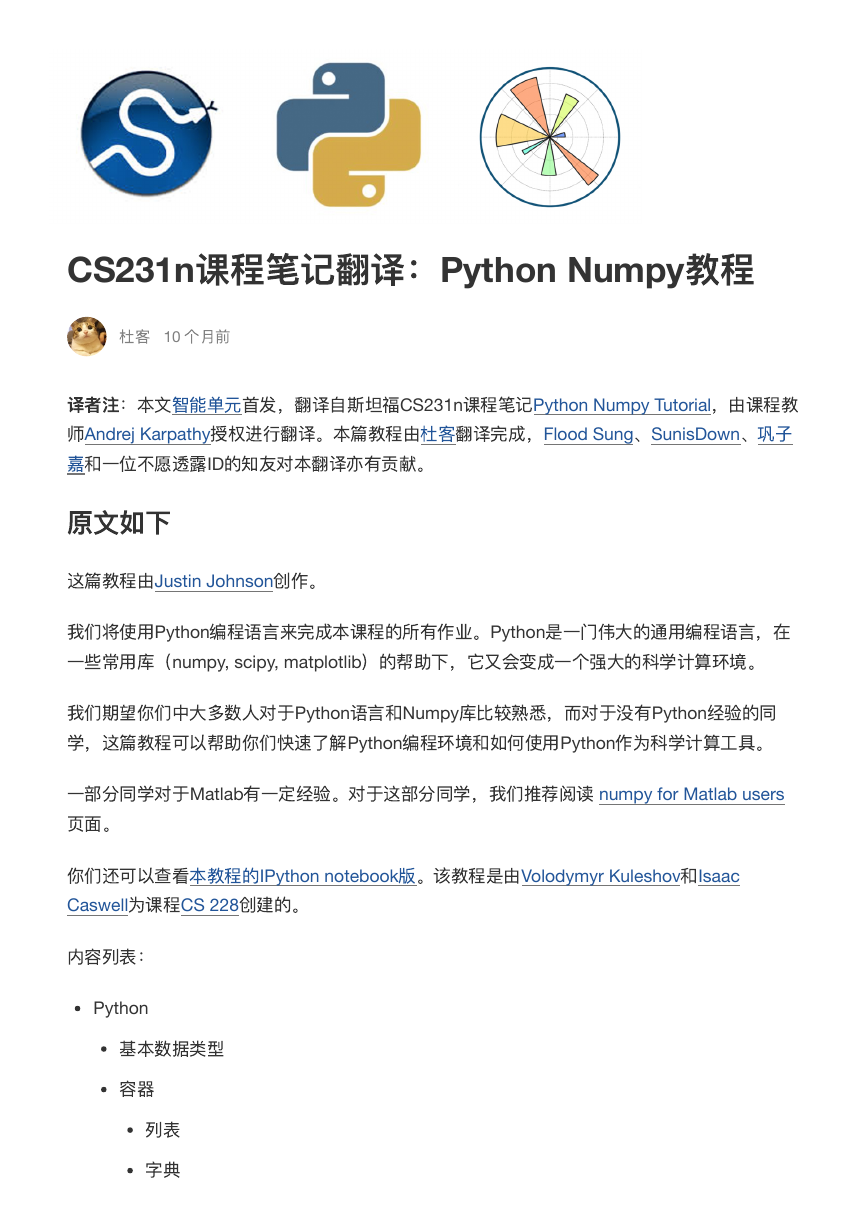

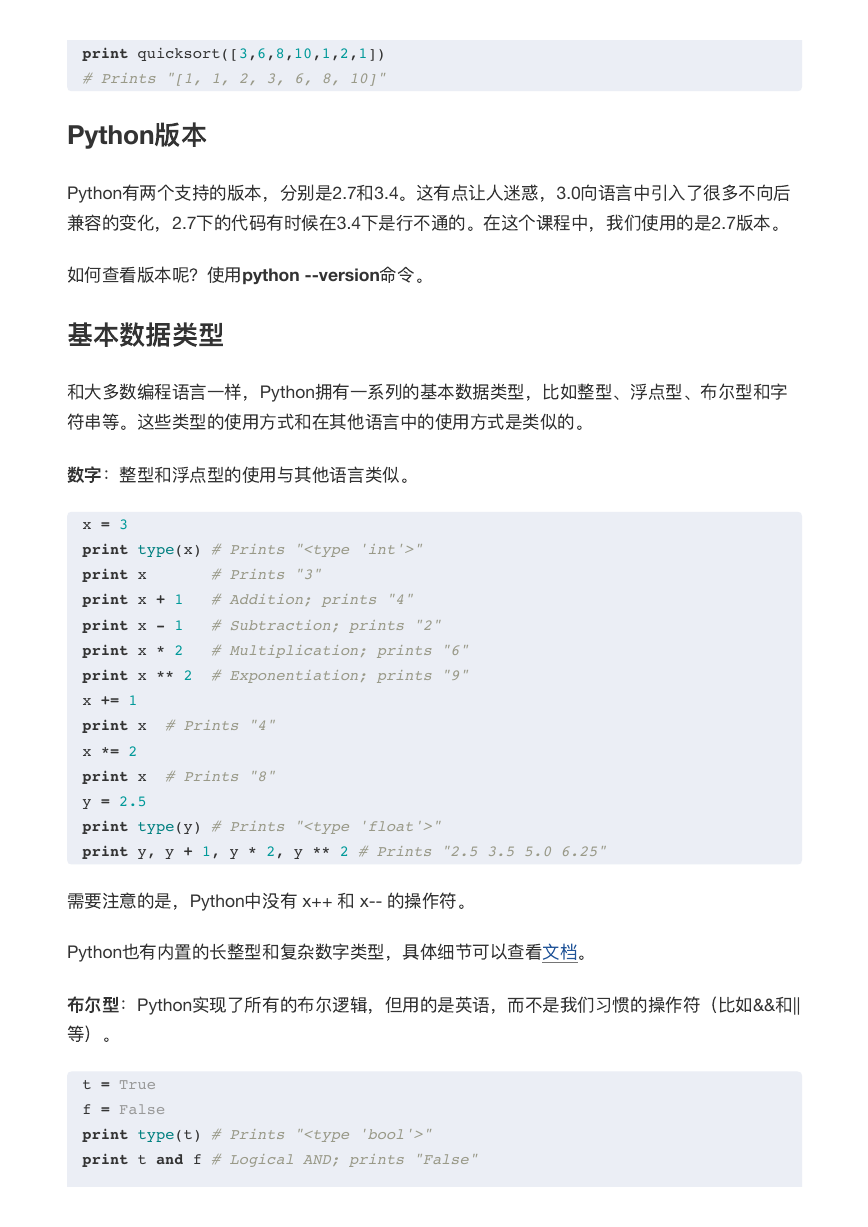

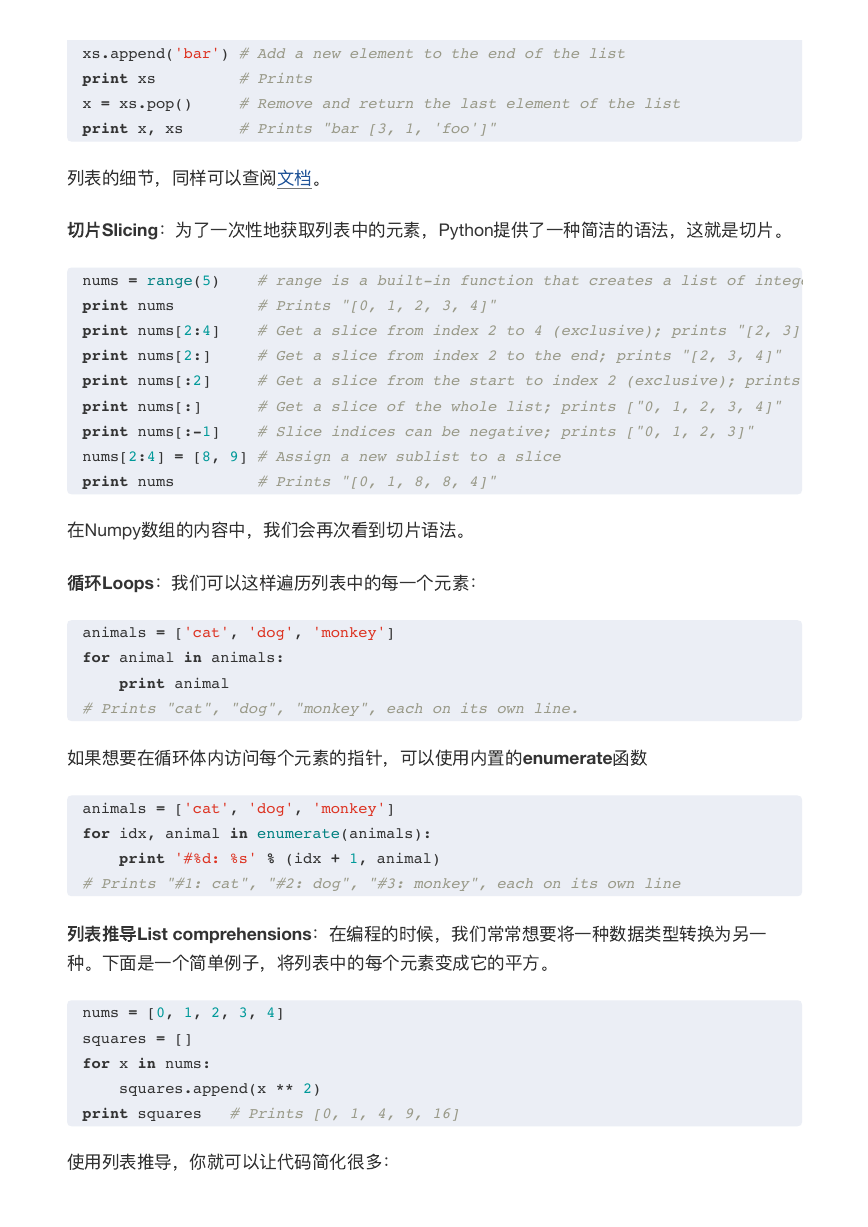
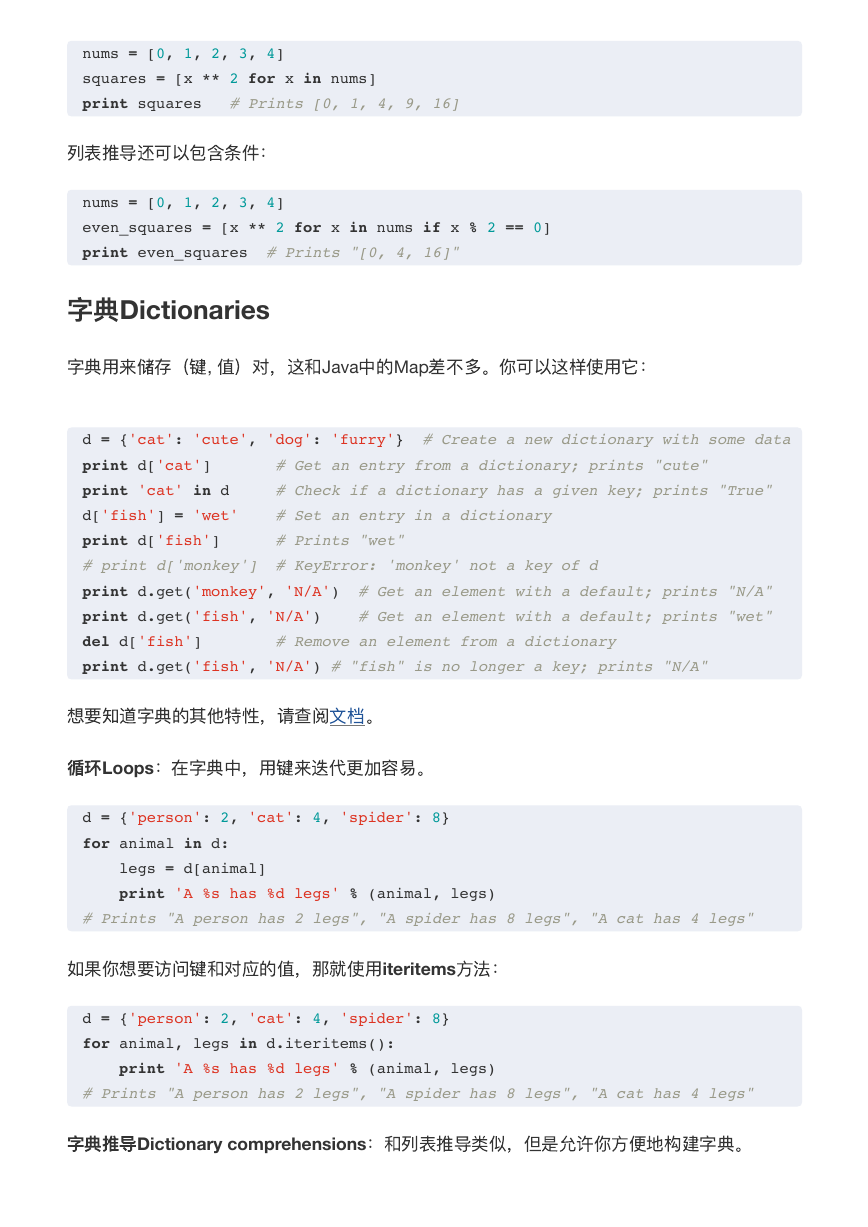

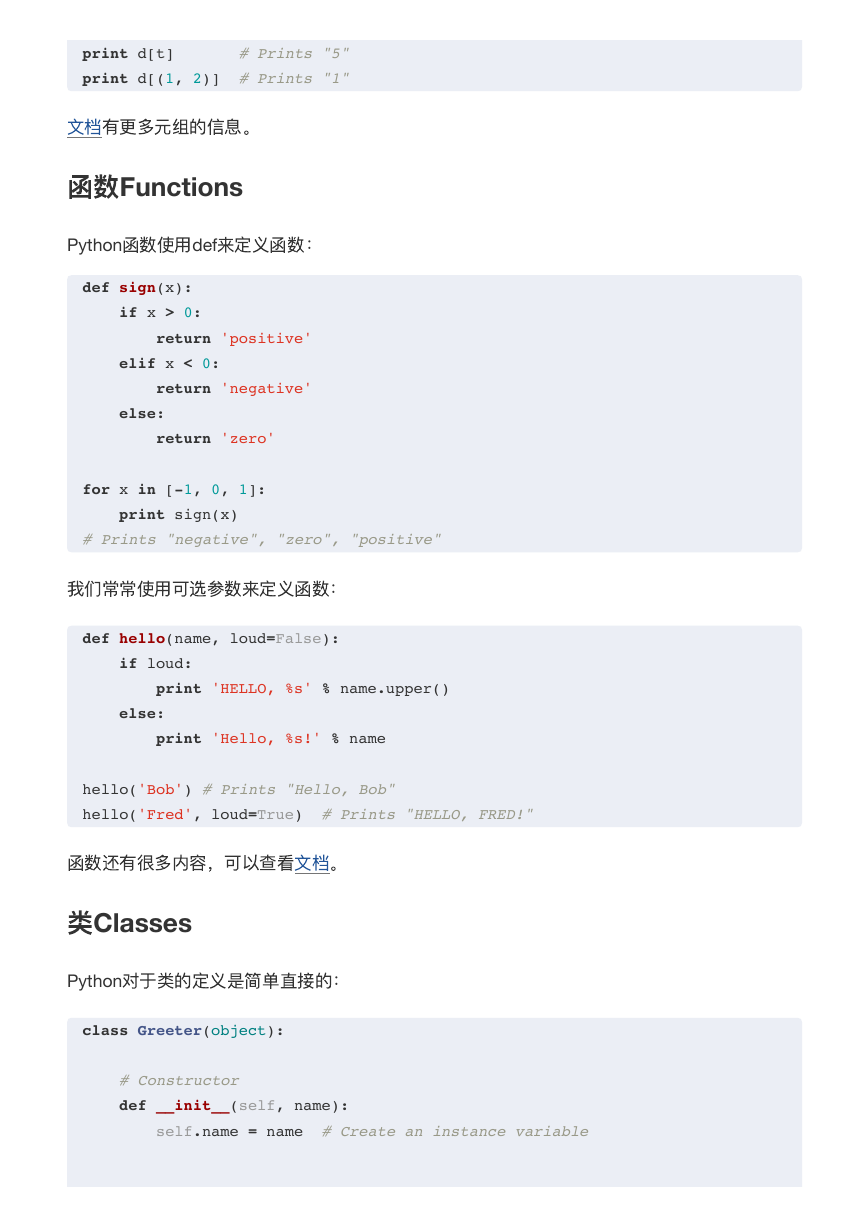








 2023年江西萍乡中考道德与法治真题及答案.doc
2023年江西萍乡中考道德与法治真题及答案.doc 2012年重庆南川中考生物真题及答案.doc
2012年重庆南川中考生物真题及答案.doc 2013年江西师范大学地理学综合及文艺理论基础考研真题.doc
2013年江西师范大学地理学综合及文艺理论基础考研真题.doc 2020年四川甘孜小升初语文真题及答案I卷.doc
2020年四川甘孜小升初语文真题及答案I卷.doc 2020年注册岩土工程师专业基础考试真题及答案.doc
2020年注册岩土工程师专业基础考试真题及答案.doc 2023-2024学年福建省厦门市九年级上学期数学月考试题及答案.doc
2023-2024学年福建省厦门市九年级上学期数学月考试题及答案.doc 2021-2022学年辽宁省沈阳市大东区九年级上学期语文期末试题及答案.doc
2021-2022学年辽宁省沈阳市大东区九年级上学期语文期末试题及答案.doc 2022-2023学年北京东城区初三第一学期物理期末试卷及答案.doc
2022-2023学年北京东城区初三第一学期物理期末试卷及答案.doc 2018上半年江西教师资格初中地理学科知识与教学能力真题及答案.doc
2018上半年江西教师资格初中地理学科知识与教学能力真题及答案.doc 2012年河北国家公务员申论考试真题及答案-省级.doc
2012年河北国家公务员申论考试真题及答案-省级.doc 2020-2021学年江苏省扬州市江都区邵樊片九年级上学期数学第一次质量检测试题及答案.doc
2020-2021学年江苏省扬州市江都区邵樊片九年级上学期数学第一次质量检测试题及答案.doc 2022下半年黑龙江教师资格证中学综合素质真题及答案.doc
2022下半年黑龙江教师资格证中学综合素质真题及答案.doc